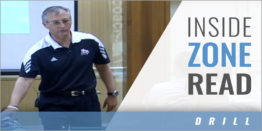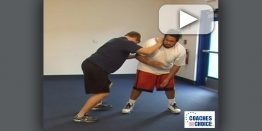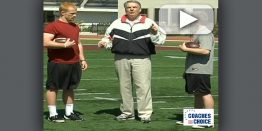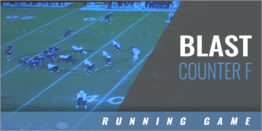| Bridge the Gap with Special Teams
As a head coach of a football team, we want to make sure we are still involved. I coach the defensive line, and I also coach the special teams. The closest way to bridge the gap to winning or to get where you want your team to be is through the special teams. How do you get to 8-2, 9-1, or win a state championship, or get to where you want to go? The fastest way to get there is through special teams. The best example of this is to look at the school where I played, and that is Virginia Tech. Who displayed this better than Frank Beamer? He took an average team and made them a great team with special teams play. No other team blocked more punts in the 1980s and 1990s than Virginia Tech under Frank Beamer. The question is: how do you close the gap? It is going to be huge if you can do it. It is one third of the game. It pays big dividends to make big plays in special teams. To me, the greatest play you can make in football is a blocked punt or a blocked kick. It is something you must work at perfecting. If you do not work on it, it is never going to happen. I want to talk about our practice routine. Every day in practice, we are going to punt the ball from our goal line. We punt the ball from the left, middle, and right hash marks. We line the football up on the one-yard line. We want the defense to come after us. We want our blockers to protect the punter. We work on punt protection every day. We work on it during the middle of practice. We do not like to do it at the start of practice because the kids are not paying attention, as they should be. We feel it is that important, and that is why we put it in the middle of our practice. This drill only takes 15 minutes of practice time. It is in the middle of practice. We go from the one- yard line and work against pressure. Our protection is very similar to what a lot of teams use today. This is how we line up (Diagram #1). Between the center and guards, we have a six- inch split. Between the guards and tackles, we are split one foot. That is our standard split. 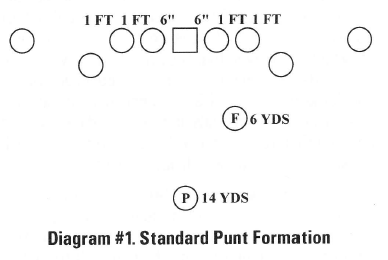 If there is one thing that can get you beat, it is a mistake in the kicking game. The more we do a drill the better we become in that technique. We like to put our players in pressure situations in practice for this drill. From there, we work on extra points. We kick three PATs, and then we start kicking field goals. We go to the 10-yard line and kick left, middle, right hash mark. Then we go to the 20-yard line, and go left, middle, and right hash mark. That is it for that aspect of the kicking game. We do this every day. We want to make sure we can punt the ball and do a great job with it. We work at it under pressure. We feel this is crucial. After practice, we may work on our punt block. We take the best athletes we have and play them on special teams. Our kids only go one way: offense or defense. We take our best athletes and put them on special teams. If you are playing kids only one way, special teams can become a very special part of what you are doing. If you are fortunate enough to two-platoon, you still must put your best players on special teams. So many big plays happen on the special teams, and you cannot afford not to have the best players on the field. It is important to have speed on the special teams. We played De La Salle High School out of California this year. I have never seen speed like they had. We played them out in California. We could not tackle them in space. What we could do was to knock them off the ball. So we decided to corner kick every kick out-of-bounds. In the second half, we did not give their return men a chance to run a kick back because we kicked the ball out-of-bounds. Between their kickoff teams and punt team, we were down 21-7 early in the game. Things were not looking good for us. The second half we settled down and ended up winning the game 23 to 21. We beat them on a field goal at the end of the game. What I am telling you is this: when you play against a team that has a lot of speed, you better have something to neutralize those special talents. They had some speed. Our punter had worked on the corner kicks and kicking the ball out-of-bounds, and it kept us in the game by doing that. The kicking game can be the great neutralizer. If you kickoff and down the ball behind the 20-yard line, it is difficult for the offense to get out of the hole. If you get them backed up on the 10- or 15-yard line, there are not many good plays they can run from there. When you go to clinics, there is always something you can get to add to your program. What can I give you that may help you in your program? I can give you a punt block that has been good to us. I want to get four volunteers to assist me with this demonstration. We have a center, guard, tackle, and tight end. We know the center is going to block back on anyone over him. Everyone else out blocks right. The fullback is assigned to the right gap. He picks up anything that gets through the line. An important point is the width of the splits. This is the reason when we punt we cut our splits down inside to six inches. The wider the guard is from the center, the more room the rush has to penetrate the gaps. We line up in an eight-man front. We want to attach the outside shoulder of the blockers. If the defense lines up in the gap, it makes the blocker's job easier. We want to line up on the inside shoulder, because that is the weak shoulder. We always want to push the inside shoulder of the blocker. That is the shoulder that we want to attack. If we attack the inside shoulder, we have a chance. Sometimes, we rush eight defenders on the punt, and against a team that may fake the punt and run or pass the ball, we can bring six on the rush. In other safe situations, we may have a return called on the punt. In the early part of the season, we block a lot of kicks. In the later part of the season, we return more punts. We want the opponents to work all season on punt protection. Then, when they think they have us figured out, we return a punt on them. They become so conscious of not getting a punt blocked, they leave the return open. One punt block that has been good for us is the block up the middle (Diagram #2). We know the center is going to block on the left inside A gap. The fullback blocks the A gap on the right of the center. Everyone is blocking outside. The right guard has the B gap, the tackle takes the C gap, and the end, has the D gap. 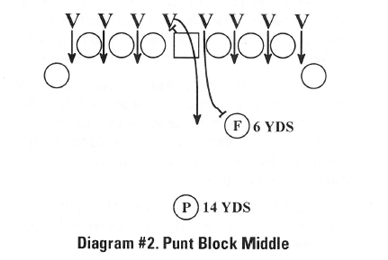 What happens to a lot of high school centers is they lunge out after the snap. They know their gap is to their left side. That opens up a seam between the center and our left side. We have both #1 rushers rushing the same gap. The fullback picks up the first rusher, and the second rusher blocks the punt. We want the first man through to get on the fullback in a hurry. We tell our man in the A gap to attach the fullback as soon as possible. One of the things you must do is to practice blocking kicks. We run a blocking-the-punt drill three times a week. You can take a little air out of the football on the drill if you want. You may want to use a Nerf® ball so the block punt is not going to sting the blacker as much. We can use one of our coaches to do the punting on the drill. We do not want to get anyone hurt on the drill. If we get a coach hurt, we can replace him, and it is no big deal. We teach our punt blockers to take the ball off the punter's foot. Typically, a punter is back 14 yards. I know it depends on the team. Some teams are closer to 12 to 14 yards deep, and some teams may be at 15 yards deep. It all is based on what we see in the scouting report. We aim for two yards in front of the sweet spot. If the punter is lined up at 14 yards, he is going to take two steps before he hits the ball with his foot. That move puts the punter at a distance of about 10 or 11 yards (Diagram #3). We want our rusher to be two yards in front of that spot, and then we want him to break to the sweet spot. We think the spot is going to be at 11 or 10 yards from the center. So we want to be eight to nine yards deep before we go for the football. The sweet spot is where the blocked kick is going to take place. We have to get deep enough so we can work to the foot of the punter. If we are at eight or nine yards in front of the punter, and then we go for the football, we can't rough the kicker. 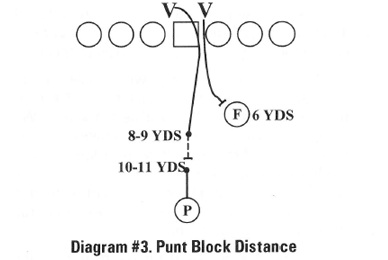 In five years, we have had no more than one roughing called against us on the punt block. You are not going to rough him if you breakdown at two yards in front of the sweet spot, and that is where the ball is going to be when the punter drops it to make the contact with the football. We work down to the football, and by doing this, we never rough the punter. There are times when you may say, "Bull crap, we are going after the punt, and we do not care if we rough the punter." You can get after their butts in some instances. Sometimes, you must have that mentality to block a punt. I can't begin to tell you how many times a blocked punt has made the difference in the outcome of a game. In our game down at Manatee, Florida, last year, we had two blocked kicks that turned the game around. We got a blocked punt in the De La Salle game last year when we had a blocked kick. I can assure you it is a game-changer. If you do not take advantage of this, you are missing out on a good part of the game. If you have two or three key players, you can block punts. Get your best player, and make sure he is the fifth man to shoot the gap, to block the punt. You can stack players behind a lineman and have them shoot the gaps as the ball is snapped. You can do a lot of different things to mix it up. If you do not work at blocking punts, you are not going to block them. On our punt returns, we middle return everything. We are not fancy on the play. We want to get everyone out of the middle of the field. We let our deep back catch the ball and take it back up the middle. The first thing we want to do is to knock the front line men back as the ball is snapped. We want to get on the inside hip of the punt team guys on the line. We want to get on that inside hip and run them back as far as possible. We are checking to see if the punt is a fake punt. Once we see it is a punt, we want to work the man out of the middle. At this point, you are allowed to use your hands to see if you can widen everyone out of the middle. We want the back to crease it down the middle on the return. That has been our philosophy through the years, We do not want to get too smart on the play. If you can return a punt, it is huge for your team. You must practice the punt return just as I said you must practice the punt blocks. You must practice all special teams. I hand pick the special teams, and I can assure you the best players are going to be on special teams. I want to give you a second idea that has been very good to us. It is a punt fake (Diagram #4). We have used this in key situations, and it has worked for us. Here is what it looks like. We snap the ball to the up back, or the fullback in this case. If we face an eight-man line, we block out at the point of attack. We block out with the other linemen.  If the defense wants to stack and play a linebacker behind the 2 technique, you may have to block it the way you zone block a play. We can block the play with a two-for two deal with the guard and linebacker. We block out on the outside man and trap the end. We bring the back around from the left to the right and cut off the block of the pulling guard. So basically, if we get a stack, we use the two-for-two block. The guard and tackle are responsible for the first down defender and the stack linebacker. On the backside, the center blocks off. We must make sure the backside tackle seals the backside gap where the guard is pulling. The tackle steps the B gap to make sure there is not penetration. We are blocking back with the center. The fullback takes the snap, and steps up on the play. The wingback comes back and then starts toward the right side of the line. He takes the ball and hits it downhill, picking up the guard. Coaching Point: Make sure the wingback gets his shoulders turned downhill when he takes the ball from the fullback. We want the back to run north and south once he gets the ball. We do not want the play to be an east to west–type play. We want it to go north to south. The key is for the wingback to cheat back just a little on the play. He must take his drop-step right away. This will put him on a better angle when he gets the ball. This play has been good for us. You have to have the nerve to run it, but it has gotten us back in some games when we needed a boost. You have great angles on this play, and if you are in a spot when you need to take a risk, take advantage of this play. You must have good players in those positions. We have our best players on special teams. We have players who can block on the line, and we have the best backs on the punt team. We are able to two-platoon, and we can work up to the special teams with the best players. The fastest way to turn a game around is with the special teams. You must get your players to buy into the special teams. You need the type of kids who can't wait to play on the special teams. At this point, I want to remind you of two things. If you want to block a punt, you must work at it. If you work on it three times a week, the kids are going to become good at it. The second point is the fact that plays in the special teams can make a big difference in a game. You can take average kids and get them to buy into the special teams and get them excited about playing on those teams. The next area I want to discuss is related to the kickoffs. We make sure our kids are hustling down the field on the kicks. We directionally kick the ball on our kickoffs. We want to bury it in a corner of the field deep (Diagram #5). There are so many bodies into that corner it is hard to come out of there. The two #1 men on the kickoff are kill guys, and they are going to the football as fast as they can.
The most important part is to out run the first group down to the 30-yard line on the kickoff. If you can outrun the first group, it becomes a 9-on-5 situation. They may have two safeties back, but we should have the advantage by outnumbering them in a small area. What we want to do is to kick the ball into the corner. We want to cut the field. We spread the men who are to cover the kickoff across the field. We have five men from the near hash mark to the sideline. We have the kicker on the hash mark. His aiming point is the numbers on the field, or between the hash marks, and the sideline at the end zone. We want to cut the field down. If we get our rushers down past the 30-yard line, there are so many people in that area that it makes it difficult to come out of that area. You want the kicker to become good at kicking the ball in the corner. If you have a kicker who can put the ball in the end zone, you may not have to work as hard on the kickoff. Some years, you have two good kickers. Other years, you may have to struggle. There is no better way to cover kickoffs than with the corner kick. However, if you have a corner-type kicker, you still must insist that the other players must hustle past that 30-yard line as soon as the ball is kicked. One drill that has helped us a lot in tackling ballcarriers in space, we call it "chase the chicken" (Diagram #6). We have a 25-yard space. It is 25 yards long, and runs from one hash mark to the other hash mark.  The big coaching point is to drop the hips and close space. We do not want the defender to spread his feet, and we do not want him to break down. The big mistake in open space is for the defender to spread his feet. We want the feet within the shoulders. We want to close space. The closer you cut down on the space, the more effective you can be with the open field tackle. The running back is going to try to score from one hash to the other hash. We are going to close down on the runner as he goes across the field. If you are going to play against a very fast return man, you should run this drill every day of the week you play him. You need to practice the drill until the players are confident they can tackle in open space. They can become good at this technique, but they have to work on it daily. As the players sprint down to the 30-yard line, they must know how to defeat the blockers as they continue downfield. It is no different in whipping a block in other situations. You want to separate, drop your hips, accelerate your feet, and then whip the block. You want to use your hands to defeat the blocker. Your hands are the most important things to use, but you need to drop the hips. You must sprint through the blacker. The big mistake the players make is to stop moving their feet. We must continue to accelerate the feet and run through the blocker. Once the defender spreads his feet, he is dead. We have even told our players to scrape their toes into the ground to keep from spreading their feet. You do not want the feet too wide. We do not have a lot of plays on our special teams. We want to be good at the plays we do run. By practicing these plays every day, we are going to get better at what we want to accomplish. We want to pressure the opponents with our special teams. We want to make them sweat. We do not give them a play off on special teams. We do not believe in that. I am going to put on the films of the plays I covered. I have cut-ups of the plays. You will be able to see what we do on our special teams. We had the blocked punt on our first goal. The technique used in the blocking of the punt is the key. Remember, it is two yards in front of the sweet spot. You want your hands together on the block. You can use a Nerf ball, or you can take the air out of a football, and then block the punt. Once they get confident that they can block a kick, there is no reason to be afraid to go after the punt. The fake punt is a play that can help you in a tight game. Any time you can make a play in the kicking game against a team that is even with you in other aspects of the game, it is huge. You can cut the field down by kicking the ball in the corner. Your kicker must be able to kick the ball where you want it to go. You have to practice the coverage as well. If your record is 5-4, 8-1, or 9-0,1 feel the fastest way to close the gap is by developing good special teams play. I do not think there is a faster way. You cannot spend enough time on special teams. Work and get the players to develop pride in special teams play. We time a lot of the things we do on special teams. We time the snap on punts and on extra points. The punt must be off in 2.0 seconds. The kick on the extra points must be made in 1.3 seconds. We take our stopwatches out, and we time those things. We make it special to be a part of our special team. Thank you for your time. Good luck.
|
|
|



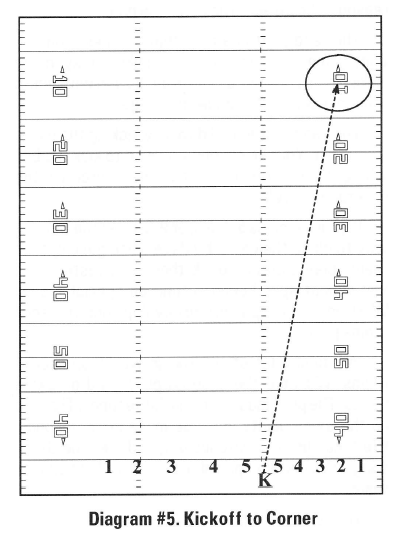 We want to get our kickoff men to hustle and get down past the 30-yard line. When the ball is caught by the deep back in that corner, our front line should be past that 30-yard line. If they are not at the 30-yard line, they are not running hard. It is a rule of thumb that they should be past the 30-yard line when that ball is caught.
We want to get our kickoff men to hustle and get down past the 30-yard line. When the ball is caught by the deep back in that corner, our front line should be past that 30-yard line. If they are not at the 30-yard line, they are not running hard. It is a rule of thumb that they should be past the 30-yard line when that ball is caught.